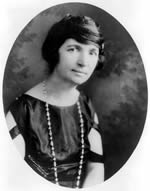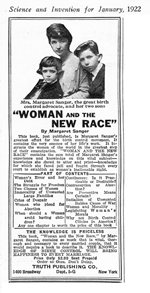
Born: 14 September 1879
Died: 6 September 1966
No woman can call herself free unless she can choose consciously whether she will or will not be a mother. 1Margaret Higgins Sanger was a pioneer in sex education and women's health. She was born in New York in 1879 to devout Irish Catholic parents. 2 Her mother died young from tuberculosis and cervical cancer. 3 Sanger was the sixth of eleven children and her mother had seven miscarriages. She saw these frequent pregnancies as the cause of her mother's early death. 4
In 1900, she entered the nursing program at White Plains Hospital and married architect William Sanger prior to her graduation. Sanger supported her family as a nurse when William Sanger could no longer work as a draftsman. 5
Sanger and her husband were part of the pre World War I bohemian culture in New York and associated with other intellectuals such as John Reed, Upton Sinclair, Mable Dodge and Emma Goldman. 6 Sanger joined the Women's Committee of New York Socialist Party and led labour protests with the Industrial Workers of the World.
In her publications, Sanger argued for birth limitation and coined the term 'Birth Control'. Sanger saw birth control as a means for the lower classes to gain independence. By limiting the number of children, the health of the mother would improve which would provide more time to take care of her children and allow women to explore their own individuality. 7
In 1912, she began writing a column on sex education titled What Every Girl Should Know for the New York newspaper Call. 8 What Every Girl Should Know was published as a book in 1917 and included topics such as menstruation and sexuality in adolescents. This was followed up with the book What Every Mother Should Know, published in 1921. 9
In 1914, Sanger published the first issue of The Women Rebel an 8 page monthly newsletter which promoted the right to practice birth control and had the slogan "No Gods and No Masters". 10 Several issues of the publication were banned and Sanger was indicted for postal obscenity laws when she distributed the pamphlets by mail. 11
Sanger fled to the UK before being jailed and it was here that she expanded her theories and understanding of contraceptives and was made aware of work of Havelock Ellis. She returned to New York in 1915. Due to public sympathy over the death of her 5 year old daughter a month before her return to the US, the obscenity charges against her were dropped. 12
In 1916, Sanger opened the first birth control clinic in the United States. The clinic was based on those that Sanger encountered in Europe. She imported hundreds of diaphragms from Europe to distribute through the clinic. Nine days after the clinic opened, Sanger and her entire staff were arrested and Sanger was sentenced to thirty days in jail. 13
Sanger established the monthly newspaper Birth Control Review in 1917 and the American Birth Control League (later known as Planned Parenthood) in 1921. 14 In 1922, she used a legal loophole that enabled physicians to prescribe contraceptives for medical reasons to open the first legal birth control clinic, the Clinical Research Bureau (renamed the Margaret Sanger Research Bureau in 1940). In 1927, Sanger helped to organize the First World Population Conference in Geneva. 15
Sanger’s 1929 publication Motherhood in Bondage is a compilation of actual letters written to Sanger begging for information on preventing unwanted pregnancies. 16 The letters were selected from hundreds of thousands of letters Sanger received in the 1920s and some of these letters survive at the Sophia Smith Collection and Library of Congress. The publication acted as effective public relations for Sanger’s argument for birth control. 17
By World War II, Sanger’s public image had faded and she retired to Arizona in 1942. Following the war, she became an activist for the international birth control movement that had come from concerns about population growth in the third world. In 1952, Sanger helped establish the International Planned Parenthood Federation and was the organisation’s first president until 1959. She helped arrange for a US company to manufacture diaphragms and raised funds for the development of spermicidal jellies and foams and hormonal contraceptives. 18
In 1957, Sanger was named 'Humanist of the Year' by the American Humanist Association. 19 She died just a few months after the US Supreme Court established the legal right to obtain birth control information in 1965. 20
Margaret Sanger was a controversial figure. She was a proponent of eugenics and some of her views have been perceived as racist. 21 Misconceptions about Sanger’s views are addressed by a fact sheet prepared for the Planned Parenthood Federation of America. 22
Despite any controversies it is clear that Sanger was an important figure in the birth control movement. In 1931, H.G. Wells was quoted as saying:
The movement she started will grow to be, a hundred years from now, the most influential of all time. When the history of our civilization is written, it will be a biological history, and Margaret Sanger will be its heroine. 23
The Margaret Sanger Papers Project is sponsored by the Department of History at New York University. Formed by Dr Esther Katz in 1985, the project seeks to identify and publish the papers of Margaret Sanger.
A list of works by or about Margaret Sanger is available on Worldcat.
'Margaret Sanger: a register of her papers in the Library of Congress' compiled by M J McElderry in 1976 is available on the Library of Congress website. The Library of Congress holdings include Sanger's personal diaries, her correspondence and speeches and writings.

Margaret Sanger, c1920.
Photograph courtesy of Wikipedia http://en.wikipedia.org/wiki/
Margaret_Sanger

Margaret Sanger and her two sons.
Photograph courtesy of Wikipedia http://en.wikipedia.org/wiki/
Margaret_Sanger
![]()
Listen to a radio broadcast of Margaret Sanger speaking in November 1953 on Edward R. Murrow's This I Believe program.
Courtesy of National Public Radio and The Margaret Sanger Papers Project.

Margaret Sanger, c.1938.
Photograph from Sanger, M. 1938, Margaret Sanger: An autobiography, WW Norton, New York, frontispiece.
Books written by Margaret Sanger and held in the Women’s Health Collection, Curtin University Library are listed below.
An Autobiography, W.W. Norton & Co., New York, 1938.
Held at Robertson Library Level 6 613.94 SANThe Case for Birth Control : a Supplementary Brief and Statement of Facts, s.n., s.l., 1917.
Held at Robertson Library Level 4 304.66 SANDebate on Birth Control, co-authored with Winter Russell, Haldeman-Julius Company, Girard, Kansas, 1921.
Held at Robertson Library Level 2 Women's Health B 176 SANHappiness in Marriage, Blue Ribbon Books, New York, 1926.
Held at Robertson Library Level 2 Women's Health 306.81 SANMotherhood in Bondage, Brentano's, New York, 1928.
Held at Robertson Library Level 4 304.66 SANMy Fight for Birth Control, Farrar & Rinehart, New York, 1931.
Held at Robertson Library Level 6 613.94 SANThe Pivot of Civilization, Brentano's, New York, 1922.
Held at Robertson Library Level 4 304.66 SANThe Practice of Contraception : an International Symposium and Survey: From the Proceedings of the Seventh International Birth Control Conference, Zurich, Switzerland, September 1930, edited by Margaret Sanger and Hannah M. Stone, Williams & Wilkins Co., Baltimore, Md., 1931.
Held at Robertson Library Level 6 613.943 PRA
Sex Problems in India : a Scientific Exposition of Sex Life and Some Curious Marriage Customs Prevailing in India From Time Immemorial to the Present Day: 2nd ed., by N.S. Phadke with a foreword by Margaret Sanger, D.B. Taraporevala, Bombay, India, 1929.
Held at Robertson Library Level 2 Women's Health 363.92 PHAWhat Every Girl Should Know, Jonathon Cape, London, 1922.
Held at Robertson Library Level 6 612.6 SAN